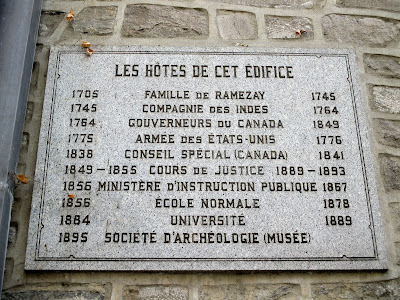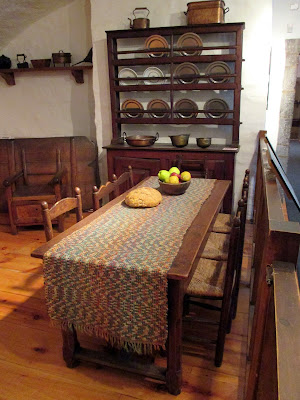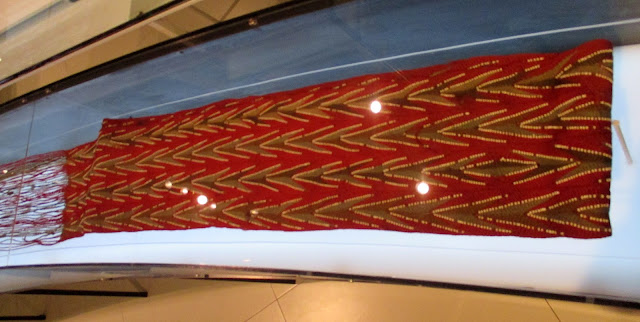I didn't expect this when I first started to revive this blog after a years-long hiatus, but this Québec-themed installment of "Beauty in Stillness" is shaping up to be quite a different beast from the earlier version I did about Seoul. Maybe it's because I'm Canadian; maybe it's because, due to circumstances entirely beyond my control, real life has been bringing big issues that I might not otherwise have touched upon into sharp relief; but the point is that no, this is not just a travelogue anymore.
Last time, when my focus was on Vieux-Québec, I decided to take the Little Big Things concept to discuss how the historic sites there could both promote and challenge the concept of "great man history". This time, in Montréal, I want to focus on a different question: what to make of the history of Canada's fur trade?
See, where Québec City was the political and military centre for a good chunk of Canada's early colonial history, Montréal was its economic hub. If Québec was the most easily defensible point, at the narrowing of the St. Lawrence River, then Montréal was the place where the St. Lawrence joined up with a vast array of other waterways: thus becoming a rendezvous for Indigenous and European traders alike.
And the thing that kept business flowing was fur. Beaver fur, to be exact.
(Replica beaver felt hat at the Royal Ontario Museum: not from Montréal,
but this is what those furs eventually became once they wound up in Europe:
those black felt hats that were ubiquitous in the 17th, 18th and 19th centuries.)
So, where do things get complicated - besides the obvious ethical dilemma of living in a country that was founded on furs? Suivez-moi, and I will show you.
(Disclaimer: This specific "Beauty in Stillness" series combines places and experiences from two separate trips to Montréal and Québec City that I took in October 2014 and August 2015. In other words: everything in this post predates the COVID-19 pandemic, and in no way do I condone traveling in violation of public health guidelines! Also, note that I have previously written about a location featured here in an older blog I ran prior to this one, so any overlap is purely because of that and not because of any plagiarism.)
Château Ramezay
Continuing from the "châteaux that don't really look like châteaux" aspect of my Québec City post, the Château Ramezay was, at one point, a major social, political, and financial hub in Montréal: as noted by the plaque hung outside listing some of the building's various occupants over the years.
The Château Ramezay is also one of my favourites out of the places I visited in Montréal - and one of the few that I actually managed to stop at both times. The second time, in August 2015, I mostly stuck to the garden behind the main building: a quiet green space that one would never guess was just a stone's throw away from a busy square filled with restaurants and stores.
However, it's the first visit from October 2014 that I want to focus on, because that is the time I actually went inside.
Like with many other historic sites in Canada, the Château Ramezay is a mixture between a recreation and a museum. Therefore, while some rooms have been done up to look more-or-less like they would have in the 18th century, there are also your standard "museum"-type displays of various artefacts that the curators have accumulated over the years.
Also, for anyone who's a nerd for historical text and primary documents, there are a few examples of those on display as well. In this case, for anyone who's interested in American history in particular, I want to direct your attention to the letter on the right, which was written by one Benjamin Franklin, among others. That letter has quite an interesting American Revolution-related attached to it: one I found so interesting that
I already featured it once on my old blog, so I won't repeat myself here.
However, where things get interesting - and complicated - is this: as a major locus for Montréal's social, economic, and political elite over the course of its colonial history, the Château Ramezay is inextricably linked to the fur trade. Along with that, inevitably, we have to examine the complex relationship between Indigenous peoples and their European colonizers - and the way that that has shaped Canadian identity ever since.
See, there are many symbols of Canadian culture that can be traced back to the intercultural contacts necessitated by the fur trade: the beaver as our national symbol is the most obvious, but even things like a love for canoes and maple syrup, both of which have Indigenous origins but were adopted by French traders and colonists. Other symbols are hybrids: the ceinture fléchée, for instance, which combined European materials with an Indigenous finger-weaving technique into a traditional sash worn by both Québécois and Indigenous people alike.
All of this hints at a relatively peaceful relationship between the different groups involved, and in some ways, there is truth in that statement. If nothing else, communities actually need to get along if they mean to trade with each other, and so it was in the best interests of both the French and the Indigenous peoples they encountered to stay on the same side.
Historical evidence also seems to point us in that direction as well; if nothing else, a good number of Indigenous communities were allied with the French against the British (and, by extension, the American colonists), whom they understood to be the greater threat. Better to work with the colonizer who wants to trade with you than the one who wants to displace you, after all. And perhaps that is how we get to the tableau from the Château's reconstructed basement with which I started this post: a reconstructed hypothetical meeting between a French colonial official, a Canadien (i.e. Québécois) militiaman, and an Indigenous delegate, all coming together to prepare for a sortie against the English Americans.
I specifically took photos of the latter two parties at the time because their manner of dress also reflects the hybridization I'm referring to. The Canadien wears an Indigenous breechcloth (hidden under his long shirt) and leggings rather than the European-style breeches; the Indigenous man has adopted a European-style coat and shirt; and both wear the plain coloured sashes that were the predecessors of the ceinture fléchee. Both appear more alike each other than the Frenchman, and for the Canadien in particular, it is evidence of that although Canada could trace its history back to its roots as a French colony, it was never really French. The France back then - that of Versailles and the l'Ancien Régime - was, in many ways, an entirely different world.
Always had been, and always will be.
Lachine Canal (specifically, the Fur Trade at Lachine National Historic Site)
Like the Château Ramezay, Lachine was, in my opinion, one of the most beautiful places I visited during the August 2015 trip to Montréal and Québec. Located in the western part of Montréal, the canal is lined with green spaces and walking paths, leading all the way to a visitor's centre located at one of its former locks.
Honestly, if you're looking for a quiet spot away from the touristy parts of Montréal to take a walk, ride a bike, or just chill out, this is probably the place to do it.
However, my focus here is not so much on Lachine's beauty, but on its significance to Canada's historical fur trade. The Lachine Canal was built in the 19th century to allow ships to pass through the Lachine Rapids westward from Montréal. Prior to that point, however, those same rapids meant that this place was a point of exchange: the large European merchant ships had to give way to Indigenous and
Canadien birchbark canoes, and vice-versa.
(This map shows how it would all work: canoes would carry furs to
Lachine from the interior; carts would then transport them to
the port in Montréal, where they were loaded onto ships bound for Europe.
Trade goods from Europe would travel inward via the opposite route.)
This brings me to the place that I really want to focus on here: the small museum dedicated to the history of the fur trade located in a former warehouse.
Compared to the Château Ramezay, which focused on the French colonization of Canada in the 17th and 18th centuries, the museum at Lachine is predominantly about the British and Scottish trade companies and their Montréal-based partners who took over the fur trade after the British conquest. And that change also came with a shift in the political tides, as Indigenous peoples who had previously sided with the French now came to ally themselves with the British - in whose interests it now was to keep the fur trade going - than with the newly-independent Americans.
But here's the thing. While there is definitely truth to this version of Canada's early history - the fur trade, still fuelled primarily by Indigenous communities, is alive and well to this day - there is danger in overly politicizing it. Or, should I say, nationalizing it.
Some of you may be familiar with the concept of the Black Legend; even if you haven't heard the term, you probably know what it means. The Black Legend was a form of anti-Spanish propaganda developed by Spain's rival European nations (most notably England and the Netherlands) in the 16th and 17th centuries that sought to paint the Spanish colonization of the Americas as a barbaric bloodbath and genocide. And to some extent, at least, the legend holds true. However, in addition to all the other problems inherent to any propaganda smear campaign - a propensity for over-exaggeration being one of them - we must also consider how such oversimplified versions of history are used.
Somewhere in there, somewhere along the way, something was bound to give. Inevitably, the Black Legend would be harnessed not to tear someone down...but to build oneself up.
Historians do not have a clear consensus on the extent to which the English - and their North American colonists - utilized the Black Legend to rationalize their own actions against Indigenous peoples. Nor am I an expert who can shed light on that particular subject. However, I do think that such a possibility would be, in all honesty, completely in line with basic human nature: most of us have, at some point in our lives, tried to cover up our own sins by pointing to others who have done worse.
And if this is the case for the English colonization - which, all my life, has been taught to me as a selfish and unfair land grab that ultimately influenced Canada's own policies in the long run - then where does that leave the French colonization? The fur trade? Us as Canadians?
Right now, in the midst of the reckoning we are currently going through as a nation, I honestly don't think that any Canadian, in good conscience, will look at things like the
Indian Act, the reservation system, the historic banning of Indigenous practices, the Indian residential schools, or the past and present sexual objectification of Indigenous women and girls in a positive light. But I do worry that, in distancing ourselves from that part of our history, that we will try to take shelter behind stories like that of the fur trade instead.
Regardes-toi, Canada. Be on your guard. Let no Black Legend take root here, for that is not how repentance comes.
Musée McCord (a.k.a. McCord Museum)
So, is there a way to end this story on a more positive note? I believe there is. While I will not presume that I have all the answers - the point of Little Big Things is really more to ask questions - I can point to one Montréal attraction that I visited during the October 2014 trip: the Musée McCord.
More specifically, its massive permanent exhibit focused on Indigenous clothing and textiles.
Now, I am not a fool. As
a former volunteer at the Royal Ontario Museum - and one who had stints in its First Peoples and Canadian galleries at that - I know that today's museums have a ton of ethical baggage of their own.
Provenance, in particular, is always going to be tricky: many of the cultural artefacts displayed in museums today were obtained by unethical or unscrupulous means.
And Indigenous artworks and artefacts are no exception. In fact, there is a certain irony at play here:: many of the pieces on display were taken (either as gifts or otherwise) from Indigenous communities by Euro-Canadian collectors who wished to "preserve" the culture that their own government was trying to ban.
I am aware that there is a continued debate about whether museum artefacts that were obtained via colonialist means should be repatriated to their source communities. That, due to a number of factors that I will not discuss here, is easier said than done. Instead, what I want to focus on is what the Musée McCord - and many other Canadian museums, including the ROM - have begun doing instead: reworking their displays to put Indigenous perspectives and voices front and centre.
As you can see, I rather went to town taking photographs at this part of the Musée McCord. The curators, guided by Indigenous consultants and advisors, really did try their best to cover all their bases: featuring clothing items and accessories from Indigenous (First Nations, Inuit, and Métis) peoples all across Canada. I can also point out that a number of the items on display are contemporary pieces: made by Indigenous artists and subsequently donated to the collection for educational purposes.
So given that, and in light of the fact that we are now coming upon Canada's National Indigenous People's Day on June 21, allow me one last look at the fur trade before I bid you adieu for now: this time, through the marks it left on Indigenous cultures.
Wampum, beads made from shells, were strung together into belts, like the top one in this photograph, by Eastern Woodlands First Nations (e.g. the Haudenosaunee, the Wendat, the Anishinaabe, etc.) as a record of trade deals, military alliances, and other similar contracts. The belts were also adopted by European traders, including the French and English, as a form of currency and as a form of official documentation in the absence of an Indigenous writing system.
Metal objects, including silver ornaments, were a common item offered by European traders in exchange for the Indigenous furs. They were incorporated into Indigenous dress and became badges symbolizing who was allied with whom. Some items, like the 18th-century Haudenosaunee heart-shaped brooch on top, were even made by Indigenous artists for their own use, combining European motifs (e.g. the Scottish
Luckenbooth design) with their own distinctive cultural elements (in this case: twin eagle heads).
The
ceinture fléchée, as described earlier, is a true hybrid born out of the fur trade. However, it is not the only one. Many Indigenous peoples adopted European fabrics (e.g. wool) and beads (first glass, then plastic) as materials for their own clothing. Items made in this fashion, like many of the ones displayed at the Musée McCord, became associated with a new form of Indigenous dress that is still alive and well today.
And perhaps, more than anything else, that is the main lesson that we can learn from museum collections like the one at the McCord. Rather than a monument to a historical past - a tableau frozen in time - like what I saw at the Château Ramezay and at Lachine, what we see here is how Indigenous cultures, like all other cultures, are living. Changing. Evolving.
Not towards any sort of Eurocentric assimilationist form, like what was intended by the Indian residential school system - but into something that was, and always will be, Native to this land.
(A First Nations elder of the Mississaugas of the Credit Nation,
whom I met during the National Indigenous Peoples Day events
in 2014 in my own home city of Toronto, Ontario.)
What's Next?
As with the series about Seoul, this one is going to have three parts. For our final stop, I want us to take a moment to consider a handful of the many sacred and religious sites in Québec. Because sometimes, whether you're religious or not, there's nothing quite like a church if you are looking for somewhere quiet.
The above blog post is part of the ongoing series Beauty in Stillness, which looks at quiet locations in some of the world's busiest places. It is also a part of the ongoing series, Memorializing History, which focuses on the different ways history is remembered and discussed in the present day. To access a master list for this and other series, click here.
Image Credits
All photographs (c) Kitty Na
Further Reading
If anyone is interested, this blog post is not the first time I've addressed the complex issues surrounding Indigenous peoples in Canada. Back in 2014, in the lead-up to National Indigenous Peoples Day (then called National Aboriginal Day), I published a four-part series of posts on my old blog. These took a more in-depth look at what I just scratch the surface of here, so I'm including links for anyone who's interested.






































































.jpg)

Comments
Post a Comment